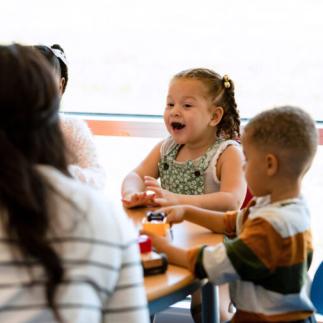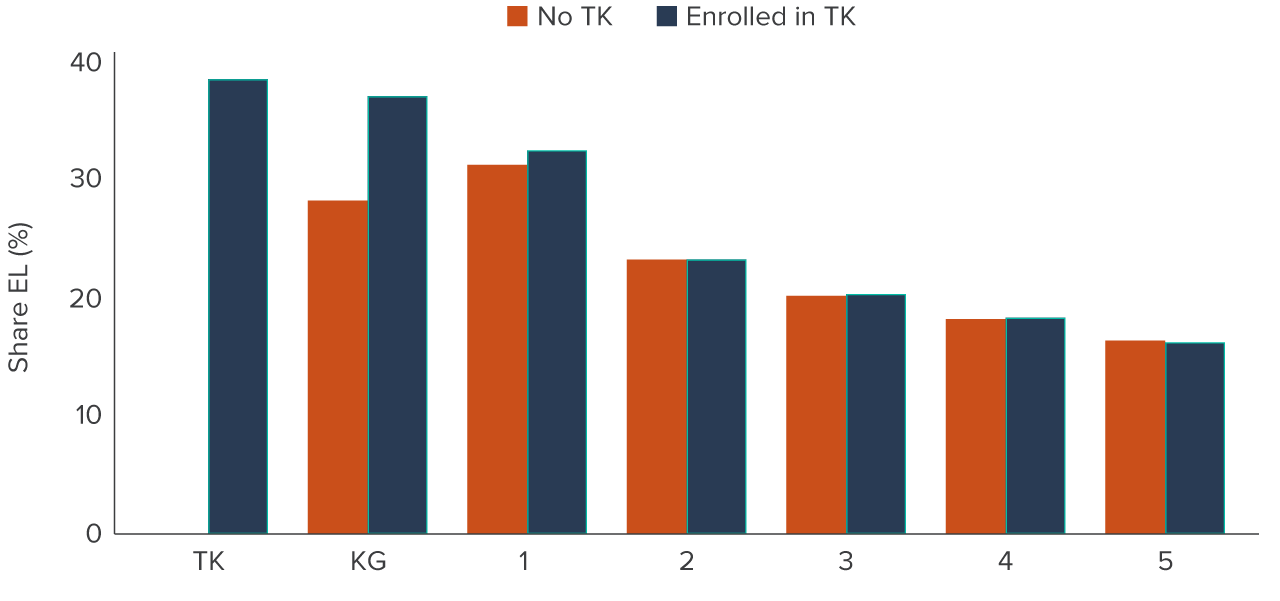Assessing Transitional Kindergarten’s Impact on Elementary School Trajectories

Summary
California’s Transitional Kindergarten (TK) program provides an additional year of schooling within the K–12 system that aims to prepare children for kindergarten. Launched a decade ago with limited eligibility, the program will be expanded to all four-year-olds by 2025–26. Little is known about TK’s longer-term impact—especially among multilingual students and students with disabilities, who might benefit from early identification. Taking stock of TK’s impact so far can help the state expand it successfully.
This policy brief was prepared as part of the CORE-PACE Research Partnership and was published by Public Policy Institute of California (PPIC).
What do we know about TK’s impact?
There are many pre-kindergarten options for four-year-olds, including the California State Preschool Program (CSPP), Head Start, other center-based care, and home-based care. According to most recent estimates, about 40 percent of four-year-olds are in publicly provided care, and about half of that care is TK. We compare TK outcomes in five large urban districts across the state to outcomes of these other, often high-quality options; differences—or lack thereof—can tell us about the relative impact of TK.
Pre-expansion TK led to earlier identification of English Learner (EL) students. TK leads to earlier identification of multilingual students in need of English-language support—and quicker reclassification of EL students—in early grades, with no net impact on EL status past grade 2. However, we also find that TK increases the likelihood of a student ever being identified as EL—leaving open the possibility that TK students are over-identified as ELs.
TK leads to earlier identification of special education needs. On average, special education needs—particularly for autism and speech/language impairments—are identified for TK students roughly half a grade earlier than for students who do not enroll in TK.
Students who enrolled in TK were more likely to be classified as ELs in early grades

Source: Administrative records from participating study districts; authors' calculations.
Note: Includes only students born within 40 days of the Dec. 2 TK eligibility cutoff. See full report and technical appendix for details on the data sample.
Evidence suggests positive social-emotional learning (SEL) outcomes, but only for English-only students. SEL skills such as self-management, social awareness, and self-efficacy are drivers of student success. We found suggestive evidence of TK’s positive effects on SEL skills among students in grades 3 to 6. These findings are somewhat promising, but when we examine outcomes separately for English-only and multilingual students, TK appears to have a large positive impact on the former group, and a small or even slightly negative impact on the latter group.
TK does not appear to improve grade 3 and 4 test scores more than other pre-K options. These findings are consistent with prior research on pre-K programs that often shows additional academic improvement fading out in elementary school—even for programs that show notable long-term improvements in high school and beyond. Our findings suggest that TK’s elementary school test score impact is comparable to that of current alternative preschool programs, such as the CSPP and Head Start.
Considerations for California’s TK expansion
Earlier special education identification may lead to improved outcomes. To the extent additional services can be provided and tailored to younger children, TK may provide an opportunity to improve these students’ outcomes through earlier interventions.
The absence of social-emotional learning benefits for multilingual students suggests the need for a deeper examination of program offerings. As TK expands to all four-year-olds, state and district policymakers should devote additional attention to how to best serve dual-language learners, to fully maximize the potential of TK. We find suggestive evidence that multilingual students see greater SEL benefits in settings with high shares of students from non–English speaking households; this may indicate that a more supportive language environment would be beneficial for these students.
Longer-term outcomes may improve as TK is expanded. TK expansion includes many changes—some of which have already been implemented—that could improve outcomes for students who participate. These programmatic changes include a TK curriculum that offers a continuum from TK through third grade. The student/teacher ratio will improve. All TK students will be screened for disabilities. And the TK school day will be longer (through the Expanded Learning Opportunity Program), potentially making TK more appealing for working families.
It will be important to continue following student trajectories to understand how TK’s impact may be evolving as it expands, and to see if initial TK cohorts experience the long-run gains observed in previous research.
Supported with funding from Sunlight Giving. Data access provided through the CORE-PACE Research Partnership. Adapted by Mary Severance from Assessing Transitional Kindergarten’s Impact on Elementary School Trajectories, by Julien Lafortune and Laura Hill.
Lafortune, J., Hill, L., & Severance, M. (2023, October). Assessing Transitional Kindergarten's Impact on Elementary School Trajectories [Policy brief]. Public Policy Institute of California. https://edpolicyinca.org/publications/assessing-transitional-kindergartens-impact-elementary-school-trajectories



